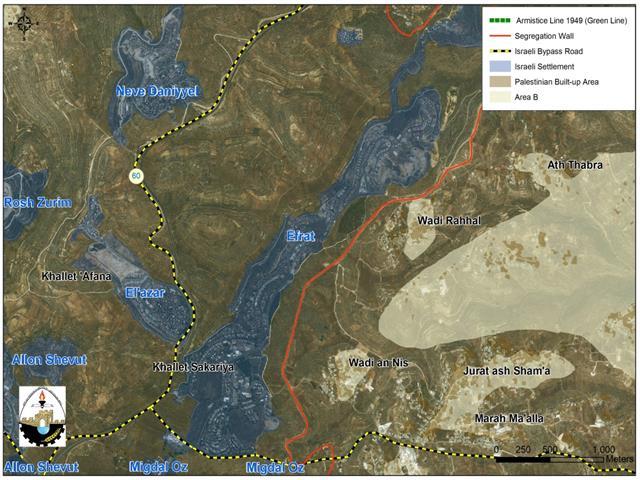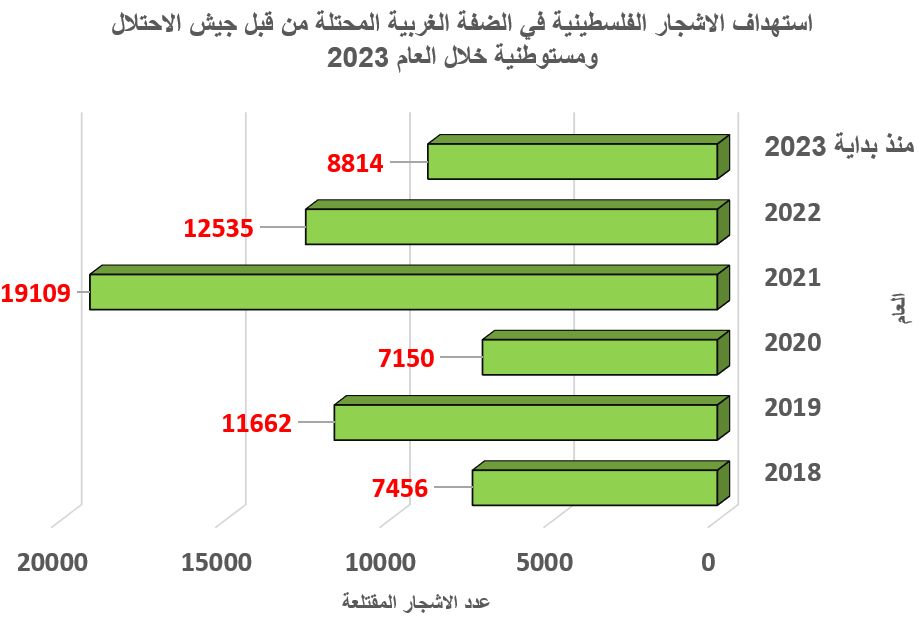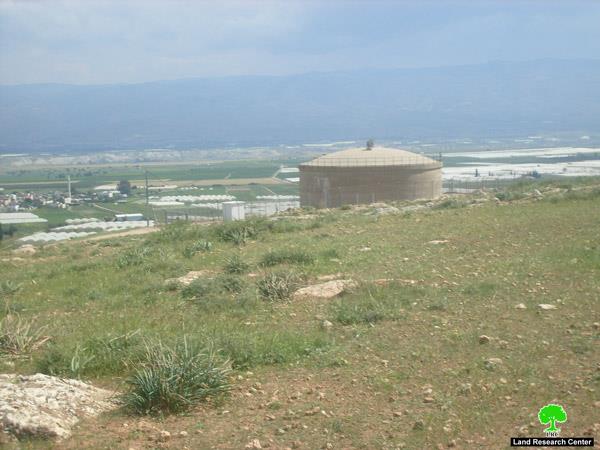On March, 28, 2011, and under the protection of the Israeli Occupation Army, a herd of Israeli settlers from the Illegal Israeli settlement of Bitar Illit
, stormed the land owned by the local farmer Jaber Taha Hussein Hamamreh from Husan village and destroyed 25 olive trees, and another 10 fruit trees. The targeted lands located in Al- Harayeq area south of Husan village west of Bethlehem Governorate.
Husan is a small Palestinian village located in the Western rural area of Bethlehem Governorate. The village is bordered by Battir village from the north, Nahalin village from the south, Wadi Fukein village from the west and Al Khader village from the east. According to the latest Israeli revised map of the Segregation Wall that was published on the Israeli Ministry of Defense website on April 30, 2007, Husan village along with three other Palestinian communities will trapped in an enclave and totally isolated from the center of life in Bethlehem city. The enclave includes the communities of Nahalin, Battir, Husan and Wadi Fukein and several hamlets. The Palestinian communities there are inhabited by more than 20,000 residents (PCBS 2010).
Settlers attack in Artas
Not so far away from Husan, is where Artas village sits west of Bethlehem Governorate; was also targeted by the Israeli settlers from the Illegal nearby Israeli settlement of Efrat, when in a repeated incident got rid of their settlements harmful waste and garbage in the Palestinian owned lands in Wadi Abu Shaheen area west of the of Artas village west of Bethlehem Governorate. The local residents of the village and the owners of the targeted lands said that this is not the first time the Israeli settlers threw their trash in their lands making the land contaminated and unfit for cultivation.
It is worth mentioning that the targeted lands located few meters away from Al Banat Monastery (The Closed Paradise of Artas) which is located south east of Artas village. It was built during the early Byzantine period. The present site contains the remains of big buildings, mosaic floor and many carved rocks.
Artas is one of the villages of Bethlehem Governorate. It is inhabited by 4,602 residents (PCBS 2010) most of whom are farmers. The village is bordered by Al Khader village from the north the Segregation Wall as well as the Illegal Israeli settlement of Efrat from the south, Dahret Al-Nada community from the east and the Segregation Wall from the west. The village of Artas occupies a total area of 4550 dunums of which only 500 dunums constitute the built-up area.
Throughout the years of the Israeli Occupation, Artas village lost a considerable area of its land, when these lands were seized by the Israeli government to establish Efrat settlement in 1979. The settlement accommodates about 8300 Israeli settler and has a totals area of 2180 dunums, 460 Dunums of which belong to Artas village. The settlement is located about 6.6 km from the 1949 Armistice line and 5.3 km south of the city of Bethlehem.
Efrat’s master plan spread on a total of 7586 dunums of lands, where it is one of the largest Israeli settlements within the Gush Etzion Settlements bloc located to the west of Bethlehem Governorate. (The Master Plan includes area of land exceeding the built-up area reserved for future expansion). See the map below:
Map of Efrat Settlement
New Demolitions in Yatta
On March 29, 2011, and without a prior notification, the Israeli Army bulldozers protected by the Israeli Occupation Army stormed Yatta town south of Hebron Governorate and headed toward Khirbet Em Nayyer east of it to demolish 12 residential tents and one barracks owned by Al-Jabbour family who were assaulted by the Israeli Army for resisting the demolition injuring seven of them: Mohammad Ahmad Al-Jabbour, Halima Mohammad Al-Jabbour, Mohammad Hussein Al-Jabbour, Issa Hussein Al-Jabbour, Hamda Mohammad Al-Jabbour, Jibreen Al-Jabbour and Zarifa Mohammad Ahmad Al Jabbour.
Mr. Abdel Aziz Abu Fannar from Yatta Municipality indicated that this was not the first time the Israeli Army demolish the targeted site, and that the Army targeted it several other times before, making it a legitimate target for the herds of the Illegal Israeli settlers of the adjacent Israeli settlement of Susiya
who usually attacked the local residents and their tents, burning the cultivated fields or/ and damaging crops in an attempt to displace them from their own lands in order to expand the Illegal settlement.
To read more about the latest Israeli attacks against Yatta town in Hebron Governorate, refer to the previously written case study (Israeli Settlers are moving forward and unabatedly in their attacks against the Palestinian People in the OPT. 20 March 2011).
Conclusion
The Israeli systematic attacks conducted by the herds of the Illegal Israeli settlers and the Israeli Army against the Palestinian people and their properties, constitute a grave breach of the International law rules and conventions:
-
Article 53 & 147 of the Fourth Geneva Convention indicated that:Extensive destruction and appropriation of property not justified by military necessity and carried out unlawfully and wantonly, is a grave breach of the Convention.
-
In addition, the uprooting and the closures are a clear violation of Article 23 of The Hague Convention, which provides that: ‘it forbidden to destroy or seize the enemy’s property, ‘unless such destruction or seizure be imperatively demanded by the necessities of war’.
-
Also under the Universal Declaration of Human Rightsadopted and proclaimed by a General Assembly resolution, 217 A (III) of, December 10, 1948, Article 17 reads: ‘No one shall be arbitrarily deprived of his property.’ Which means it bans Israel from destroying or confiscating the property of the Palestinians at any case
[1] The settlement of Bitar Illit is located west of Bethlehem city and was built in the year 1985 on lands confiscated from 3 Palestinian villages in the western rural area of Bethlehem Governorate, Husan, Nahalin and Wadi Fukien. Today, the settlement occupies a total land area of 4686 dunums and houses 36,400 Israeli settlers.
[2] The illegal Israeli Settlement of Susiya was established in 1983; over 953 dunums of Yatta lands .The settlement has a population of 792 settlers.















